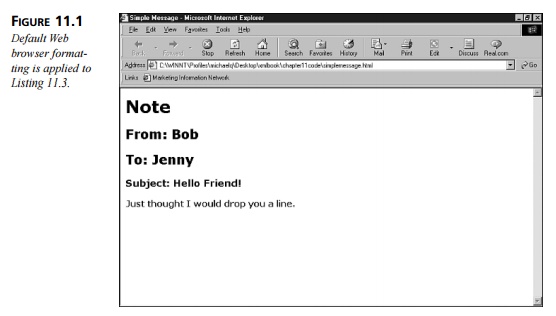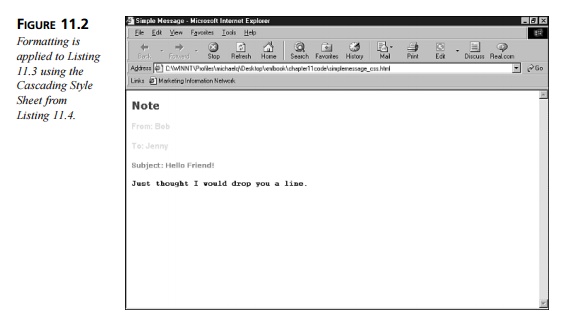Chapter: XML and Web Services : Building XML-Based Applications : Formatting XML for the Web
A Brief History of CSS
A Brief History of CSS
In 1996, about the time the DSSSL standard was being finalized by the
ISO, the W3C organization was finalizing its own style language. On December
17, 1996, Cascading Style Sheets Level 1 (CSS1) became an official W3C
recommendation. CSS1 was intro-duced with the intention of separating, as much
as possible, the formatting (visual ren-dering) from HTML-structured documents.
HTML, an SGML application, was originally introduced to simplify the
visual rendering of structured data for Web-enabled audiences. However, as
vendors (especially Netscape and Microsoft) introduced new versions of their
Web browsers, more custom extensions to HTML for rendering were introduced.
Some features of HTML were adopted by the Web browsers, whereas others were
ignored or changed. The original intent of HTML became increasingly splintered
as the HTML implementations of competing Web browsers became more and more incompatible.
For this reason, CSS1 was an attempt to separate much of the rendering (font
sizes, colors, spacing, and so on) from HTML—that is, to help remove the
disparities between the Web browsers.
In addition to separating rendering from HTML, CSS1 is much simpler to
implement than DSSSL-Online, the Web version of DSSSL. CSS1 has a simpler,
easier-to-under-stand syntax. It allows for a much more granular control of
layout and formatting. CSS1 was developed to be very flexible and maintainable
through the use of separate style sheets that can be referenced by many HTML
pages simultaneously.
Listing 11.3 shows a very simple example of what a
message might look like in a HTML page (building upon the SGML message example
in Listing 11.1). The code from this listing, simplemessage.HTML, can be downloaded from the Sams Web site.
LISTING 11.3 Very Simple HTML Page
<html>
<head>
<title>Simple
Message</title>
</head>
<body>
<h1>Note</h1> <h2>From: Bob</h2> <h2>To:
Jenny</h2>
<h3>Subject: Hello Friend!</h3>
<h4>Just thought I would drop you a line.</h4> </body>
</html>
Listing 11.3 has no special formatting applied to it. It is a simple
HTML page that gives no indication about the type of font, font size, colors,
and so on that should be applied to it when rendered in a Web browser. In this
case, the formatting applied will be the default settings associated with the
HTML tags for a Web browser that loads the page. Figure 11.1 shows how this
page would be rendered using the default settings in Internet Explorer 5.5.

You can see there is nothing fancy about the
formatting for this page. However, it is pos-sible to apply a CSS1 style sheet
to this page to affect the rendering. Applying a style sheet to the page will
override the default formatting of the Web browser. Listing 11.4 shows a CSS1
style sheet that could be used to apply styles to the HTML page in Listing
11.3. The code for this listing, simplecss.CSS, can be downloaded from the Sams Web site.
LISTING 11.4 Simple CSS1 Style Sheet
h1
{
font-family:verdana; font-size:20px; font-weight:bold; color:#0000ff
}
h2
{
font-family:arial; font-size:15px; font-weight:bold; color:#00ff00
}
h3
{
font-family:sans serif; font-size:13px; font-weight:bold; color:#ff0000
}
h4
{
font-family:courier; font-size:12px; color:#000000
}
On the surface, a CSS1 style sheet is very similar to a DSSSL style
sheet. However, beyond some subtle syntax differences (CSS is a bit more
straightforward), the big dif-ference is that the CSS style sheet does not have
a Document Type Declaration. This is because the rules for applying and parsing
CSS style sheets are built in to the Web browser’s parsing engine. There is no
need for a DTD in a CSS1 style sheet. This removes a lot of the overhead
inherent in DSSSL.
Only a single line of code must be added to the HTML page (from Listing
11.3) in order to reference the style sheet in Listing 11.4. Listing 11.5 shows
the updated HTML page. The code for this listing, simplemessage_css.HTML, can be downloaded from the Sams
Web site.
LISTING 11.5 Very Simple HTML Page
<html>
<head>
<title>Simple
Message</title>
<!-- references the
style sheet from
Listing 11.4 -->
<link rel=”STYLESHEET” type=”text/css” href=”simplecss.css” />
</head>
<body>
<h1>Note</h1> <h2>From: Bob</h2> <h2>To:
Jenny</h2>
<h3>Subject: Hello Friend!</h3>
<h4>Just thought I would drop you a line.</h4> </body>
</html>
The only change from Listing 11.3 to Listing 11.5 is that the link element has been added to the
page right after the title element inside the head element. The link ele-ment is an empty element with three attributes. The rel attribute establishes that the
link is for a style sheet. The type attribute establishes the MIME type for a CSS style sheet. Finally, the
href attribute
is, of course, the URL for the style sheet. Now, when visited by a Web browser,
the page will be rendered using the settings found in the style sheet that is
referenced by the href attribute of the link element. Figure 11.2 shows how the page in Listing 11.5 would appear in
Internet Explorer 5.5.

Compare Figure 11.2 to Figure 11.1. It is easy to see that applying the
CSS1 style sheet from Listing 11.4 has radically affected the rendering of the
HTML. Each of the elements—<h1>, <h2>, <h3>, and <h4>—are rendered differently according to the font-family,
font-size,
font-weight, and color settings from the style sheet.
Of course, this all becomes academic if Web browsers do not adopt W3C
recommenda-tions such as CSS1. In the last few years, the major Web browser
vendors have finally finished adding (almost) complete support for CSS1. The
only problem with this is that CSS2 is the newest recommendation for Cascading
Style Sheets. CSS2 was ratified as a W3C recommendation in May 1998. Since CSS2
was ratified in 1998, at the time of this writing, only Opera 5 and Netscape 6
have broad support for CSS2. It is this lag in adopting new CSS technology by
the Web browser vendors that has been instrumental in Web developers continuing
to use older HTML formatting tags such as <font>, <u>, and <i>.
CSS is not only used to apply formatting to HTML. In the next section,
we will cover how CSS may be used to apply formatting to XML documents for
display in Web browsers.
Related Topics